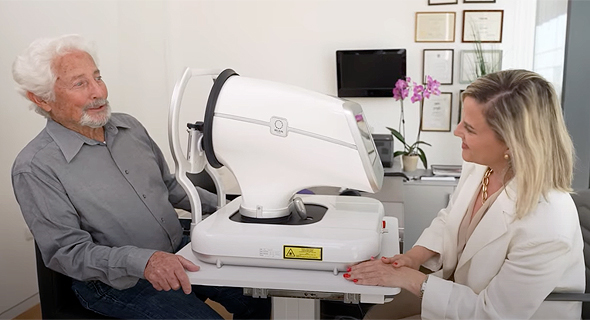Interview
Belkin Vision is using automated laser surgery to tackle glaucoma, a disease that can lead to irreversible blindness
08:4030.01.22
“The eye is a very small ball with intraocular fluid that needs to remain at a certain pressure. If that pressure is too high, it pushes the optic nerve – that relays messages to the brain – and causes damage that translates into blindness,” explained Daria Lemann-Blumenthal, CEO of Belkin Vision, to CTech in an interview. “And it happens gradually. The visual field shrinks but patients aren’t aware of that deterioration. Only once they start experiencing tunnel vision, do they realize that something is wrong. It’s irreversible, and can’t be resolved. In the case of cataracts, the lens in the eye gets old and grows foggy with age, but can be replaced with surgery. Unfortunately, in the case of glaucoma, optic nerves cannot be restored. Classic treatments for glaucoma focus on lowering that pressure in the eye, through eye drops or surgery, but aren’t as effective and are very costly.”
 Daria Lemann-Blumenthal. Photo: YML Photography
Daria Lemann-Blumenthal. Photo: YML Photography
The company was founded in 2013 by Prof. Michael Blumenthal, of Tel Aviv University, an expert in treating glaucoma. Belkin Vision’s direct-SLT (Selective Laser Trabeculoplasty) delivers 120 laser pulses per second to the limbus area, which located behind the eye’s trabecular meshwork – an area where fluid can accumulate leading to high pressure and blindness – and allows the area to self-drain its intraocular fluid. Belkin’s solution can be used in any clinic or hospital for those diagnosed with early-onset glaucoma. Diagnosing glaucoma in the early stages is critical for patients, and most ophthalmologists recommend that adults starting at the age of 40 get their eyes checked annually.
Activating a bioresponse
Lemann-Blumenthal added that the eye can be compared to a clogged sink. “Either you can close the tap but then you won’t have water, or you can open the drainage and attempt to fix it. That’s what we’re trying to do by aiming our lasers at the trabecular meshwork system in the eye which is like a mesh net that can be drained. Over the years, that net gets clogged, and we want to drain that fluid.” That particular area lies between the iris and the sclera (or on the border between the colored iris and white section of the eye), and can’t be seen. And the earlier glaucoma is detected, the better. The majority of patients are only diagnosed during earlier stages of the disease, and are searching for non-invasive solutions. In a recent study, some 50% of patients grew weary and stopped taking prescription eye drops after a year, leading to further deterioration since the disease is unfelt. But through laser eye surgery, the mechanism can be reversed. She explained that the laser causes a quasi-inflammation in the eye, allowing the ‘shock’ to be absorbed by the pigmented cells, which in turn activate the white blood cells, and stimulate a bioresponse where the body works to rapidly drain that area.
Eagle-eye
In laser surgeries of this type, doctors use a mirrored lens to visualize the area, which helps them divert the laser beams to the correct location. Belkin’s offering, aptly named “Eagle” delivers 120 automated laser pulses to different areas within a second, and is automated by a machine. The D-SLT contains a sophisticated image processing algorithm to locate the limbus in the eye. The solution also requires continual use of drops, and is “painless,” according to Lemann-Blumenthal. Currently, it has been tested at Sheba Medical Center’s Ophthalmology Department by Dr. Mordechai Goldenfeld, where 28 patients were treated, with half receiving Belkin’s automated-laser version. It has also been tested at the upscale Moorfields Eye Hospital in the U.K. In order for the treatment to be effective, patients are advised to receive it annually.
 Belkin Laser’s device can dramatically improve vision for patients suffering from glaucoma. Photo: Yosee Gamzoo Letova
Belkin Laser’s device can dramatically improve vision for patients suffering from glaucoma. Photo: Yosee Gamzoo Letova
The company is based in the southern town of Yavne. It received funding initially from the RAD BioMed Accelerator program, and has so far raised a total of nearly $38.8 million through a combination of equity and grants, including from the Israel Innovation Authority and the Office of the Chief Scientist as well as from Zicom Holdings, Rimonci Capital, Santen Ventures, CR-CP Life Science Fund, C-Mer Eye Holdings, and BioLight Life Sciences. In December, it received a grant through blended financing for a total sum of $19.8 million from the European Innovation Council (EIC).
Lastly, Lemann-Blumenthal noted the steadfast interest of Asian venture capital firms in Belkin’s technology. People of Asian descent genetically have a predisposition to develop angle-closure glaucoma, due to the anatomical structure of Asian eyes. But Belkin wants to fix that. She added: “If you believe in something, you have to do something about it, not just talk about it.”
Credit: Source link





















